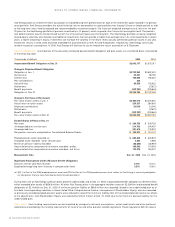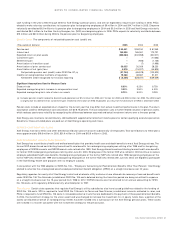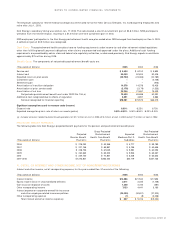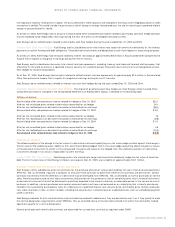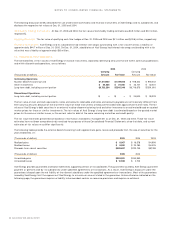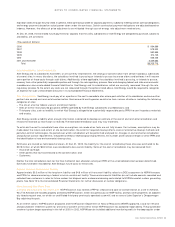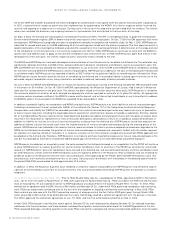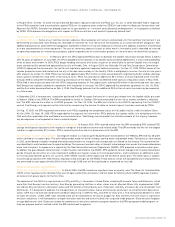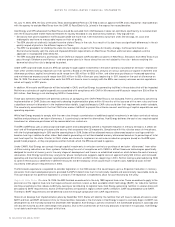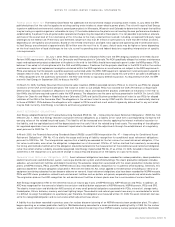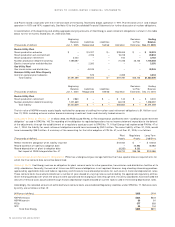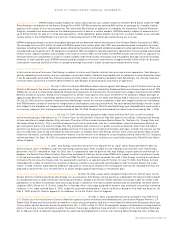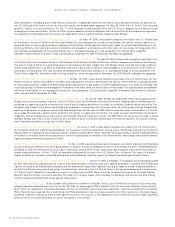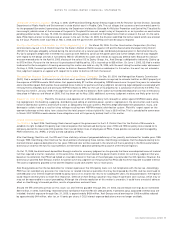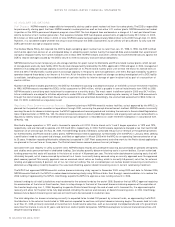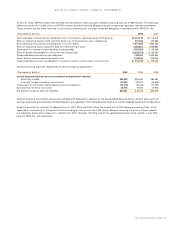Xcel Energy 2005 Annual Report Download - page 72
Download and view the complete annual report
Please find page 72 of the 2005 Xcel Energy annual report below. You can navigate through the pages in the report by either clicking on the pages listed below, or by using the keyword search tool below to find specific information within the annual report.the former MGP site to better characterize the extent and degree of contaminants in that aquifer while the coal tar removal system is operational.
In 2002, a second interim response action was also implemented. As approved by the WDNR, this interim response action involved the
removal and capping of a seep area in a city park. Surface soils in the area of the seep were contaminated with tar residues. The interim
action also included the diversion and ongoing treatment of groundwater that contributed to the formation of the seep.
On Sept. 5, 2002, the Ashland site was placed on the National Priorities List (NPL). The NPL is intended primarily to guide the United States
Environmental Protection Agency (EPA) in determining which sites require further investigation. On Dec. 7, 2004, the EPA approved, with minor
contingencies, NSP-Wisconsin’s proposed work plan to complete the remedial investigation and feasibility study. On Feb. 1, 2005, NSP-Wisconsin
submitted its revised work plan to the EPA addressing all of the contingencies raised with the previous proposal. The final approval results in
specific delineation of the investigative fieldwork and scientific assessments that must be performed. A determination of the scope and cost
of the remediation of the Ashland site is not currently expected until 2007 or 2008. NSP-Wisconsin continues to work with the WDNR to
access state and federal funds to apply to the ultimate remediation cost of the entire site. In 2005, NSP-Wisconsin spent $2.8 million in the
development of the work plan, the interim response action and other matters related to the site.
The WDNR and NSP-Wisconsin have each developed several estimates of the ultimate cost to remediate the Ashland site. The estimates vary
significantly, between $4 million and $93 million, because different methods of remediation and different results are assumed in each. The
EPA and WDNR have not yet selected the method of remediation to use at the site. Until the EPA and the WDNR select a remediation strategy
for the entire site and determine NSP-Wisconsin’s level of responsibility, NSP-Wisconsin’s liability for the cost of remediating the Ashland site
is not determinable. NSP-Wisconsin has recorded a liability of $19.7 million for its potential liability for remediating the Ashland site. Since
NSP-Wisconsin cannot currently estimate the cost of remediating the Ashland site, the recorded liability is based upon the minimum of the
estimated range of remediation costs, using information available to date and reasonably effective remedial methods.
On July 2, 2004, the WDNR sent NSP-Wisconsin an invoice for recovery of past costs incurred at the Ashland site between 1994 and March 2003
in the amount of $1.4 million. On Oct. 19, 2004, the WDNR, represented by the Wisconsin Department of Justice, filed a lawsuit in Wisconsin
state court for reimbursement of the past costs. This lawsuit has been stayed until further action by either party. NSP-Wisconsin is reviewing
the invoice to determine whether all costs charged are appropriate and has recorded an estimate of its potential liability. All appropriate
insurance carriers have been notified of the WDNR’s invoice and the lawsuit, and will be invited to participate in any future efforts to address
the WDNR’s actions. All costs paid to the WDNR are expected to be recoverable in rates.
In addition to potential liability for remediation and WDNR oversight costs, NSP-Wisconsin may have liability for natural resource damages,
including the assessment thereof (collectively NRDA) at the Ashland site. Section 107 of the Comprehensive Environmental Response,
Compensation and Liability Act (CERCLA) as amended, provides that a natural resource damages trustee may recover for injury to, destruction
or loss of natural resources, including the reasonable costs of assessment, resulting from releases of hazardous substances. Similarly, Section
311 of the Federal Water Pollution Control Act (or Clean Water Act) provides the federal and state governments with the ability to recover costs
incurred in the restoration or replacement of natural resources damaged or destroyed as a result of a hazardous substance discharge. In
addition to liability for injuries to or loss of services caused by a release from the Ashland site, NSP-Wisconsin could face exposure for
additional indirect injuries that could result from the implementation of various remedial technologies during the cleanup phase of the
project. NSP-Wisconsin has indicated to the relevant natural resource trustees its intent to pursue a cooperative assessment approach to the
NRDA for the Ashland site whereby the question of natural resource damages is assessed and resolved in tandem with the studies required
for selection of a cleanup remedy or remedies. It is, however, unknown at this time whether a cooperative assessment NRDA approach will
be adopted at the Ashland site. Therefore, NSP-Wisconsin is not able to estimate its potential exposure for natural resource damages at the
site, but has recorded an estimate of its potential liability based upon the minimum of its estimated range of potential exposure.
NSP-Wisconsin has deferred, as a regulatory asset, the costs accrued for the Ashland site based on an expectation that the PSCW will continue
to allow NSP-Wisconsin to recover payments for environmental remediation from its customers. The PSCW has consistently authorized
recovery in NSP-Wisconsin rates of all remediation costs incurred at the Ashland site, and has authorized recovery of similar remediation costs
for other Wisconsin utilities. External MGP remediation costs are subject to deferral in the Wisconsin retail jurisdiction and are reviewed for
prudence as part of the Wisconsin biennial retail rate case process. Once approved by the PSCW, deferred MGP remediation costs, less
carrying costs, are historically amortized over four or six years. Carrying costs vary directly with the balance in the deferred account and for
the period 1995–2005 are estimated to total approximately $1.8 million.
In addition, in 2003, the Wisconsin Supreme Court rendered a ruling that reopens the possibility that NSP-Wisconsin may be able to recover
a portion of the remediation costs from its insurance carriers. Any insurance proceeds received by NSP-Wisconsin will operate as a credit to
ratepayers.
Fort Collins Manufactured Gas Plant Site
Prior to 1926, Poudre Valley Gas Co., a predecessor of PSCo, operated an MGP in Fort Collins,
Colo., not far from the Cache la Poudre River. In 1926, after acquiring the Poudre Valley Gas Co., PSCo shut down the MGP site and has sold
most of the property. An oily substance similar to MGP byproducts was discovered in the Cache la Poudre River. On Nov. 10, 2004, PSCo
entered into an agreement with the EPA, the city of Fort Collins and Schrader Oil Co., under which PSCo performed remediation and monitoring
work. PSCo has substantially completed work at the site, with the exception of ongoing maintenance and monitoring. In May 2005, PSCo
filed a natural gas rate case with the CPUC requesting recovery of cleanup costs at the Fort Collins MGP plant spent through March 2005,
which amounted to $6.2 million to be amortized over four years. Xcel Energy reached a settlement agreement with the parties in the case.
The CPUC approved the settlement agreement on Jan. 19, 2006, and the final order became effective on Feb. 3, 2006.
In April 2005, PSCo brought a contribution action against Schrader Oil Co. and related parties alleging Schrader Oil Co. released hazardous
substances into the environment and these releases increased the migration and environmental impact of the MGP byproducts at the site.
PSCo requested damages, including a portion of the costs PSCo incurred to investigate and remove contaminated sediments from the Cache
70 XCEL ENERGY 2005 ANNUAL REPORT
NOTES TO CONSOLIDATED FINANCIAL STATEMENTS


